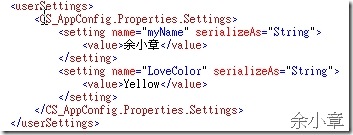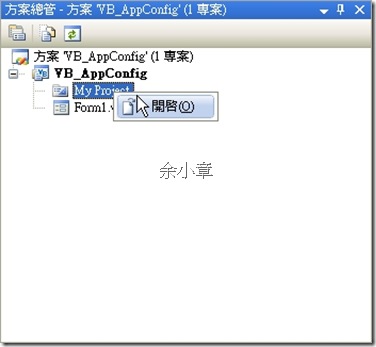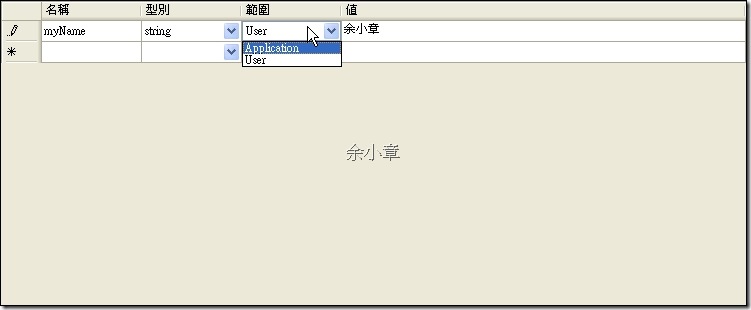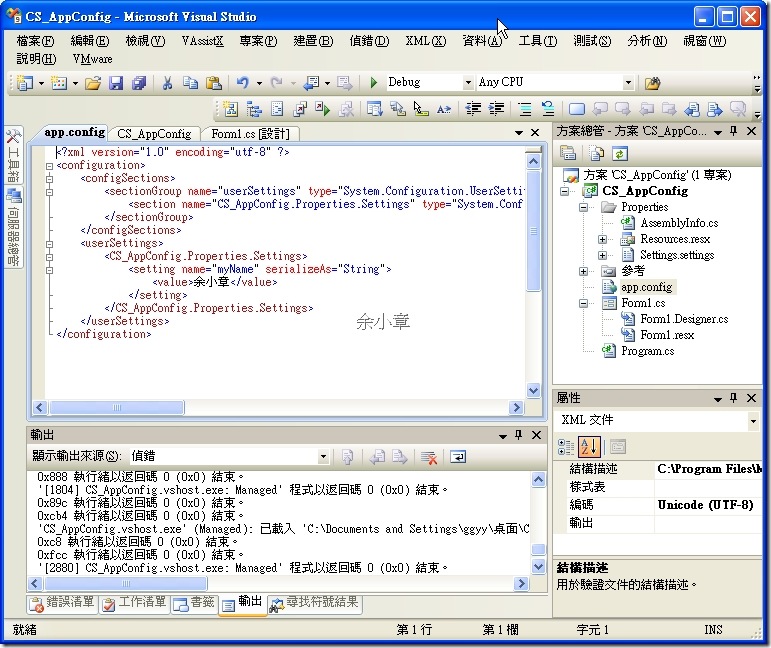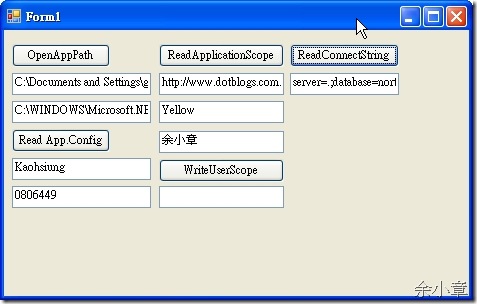[C#.NET][VB.NET] 應用程式組態設定檔 / Application Configurable File (一)
1.組態檔組態檔(exe.config)必須與應用程式(.exe)存在於同一層目錄,檔名必須與應用程式檔名相同+.config,如下圖所示:
2.組態檔是一種XML格式文件,裡面包含了應用程式的所需的配置設定,必免將程式的變數寫成死變數(hard-coding variable),別聽到XML別馬上傻傻的用之前提到的XmlSerializer 序列化,System.Configuration 命名空間 的 ConfigurationManager 提供了讀寫組態檔的方法。
3.組態檔機器等級(Machine Level),位於"C:\WINDOWS\Microsoft.NET\Framework\v2.0.50727\CONFIG\machine.config",所有的程式都會套用它的組態設定,修改時請先備份,以便改壞了還可以還原。
4.組態檔應用程式等級(Application Level),它與應用程式同一目錄。
5.VS預設未將System.Configuration 命名空間加入參考,所以開發者必須要手動加入,並且using System.Configuration。
6.ConfigurationManager 有兩個屬性分別是ConnectionStrings與AppSettings;這兩個屬性分別對應到組態檔的<connectionStrings>與<appSettings>區段中。參考.NET Framework 的組態檔結構描述
7.<appSttings>區段中開發者可以針對應用程式設定,將其設定存放至<appSttings>區段,它是以key/value方式存放。同理<connectionStrings>也是與<appSttings>有相同的功能,但<connectionStrings>是用name/connectionString方式存放。
8.應用程式的組態範圍分為兩個一是Application,另一個為User
Application是指該應用程式所有使用者的共享資訊,例如像是公司行號、電話、統編等;固定且不會依使用者改變的而改變。而Application範圍是唯讀的項目(有方法可寫,不過很麻煩),讀取的方式如下:
VB用My.Setting
C#用Properties.Setting.Default:
textBox7.Text = CS_AppConfig.Properties.Settings.Default.myName;
CS_AppConfig為專案的名稱,C#在建立組態時會在專案下產生一個Prooerties命名空間的Setting類別,用Default屬性就能取得範圍內容了。
兩者的語法存取有所不同
User是指應用程式登入使用者的個別組態,每個使用者可以擁有自己的設定,並且存放在使用者組態檔案中,它可供應用程式讀寫。
如何建立專案的設定組態
1.開啟專案的"屬性"
2.選取"設定"→依情況設定型別、範圍。
建立好之後就能在專案看到app.config的檔案以及內容
C#完整範例
private void button1_Click(object sender, EventArgs e)
{ //引用Configuration類別開啟組態 Configuration cf1 = ConfigurationManager.OpenExeConfiguration(ConfigurationUserLevel.None);
this.textBox1.Text = cf1.FilePath; Configuration cf2 = ConfigurationManager.OpenMachineConfiguration();
this.textBox2.Text = cf2.FilePath; }
private void button2_Click(object sender, EventArgs e)
{ //讀取<appSettings>標籤 ConfigurationManager.RefreshSection("appSettings"); this.textBox3.Text = ConfigurationManager.AppSettings["myHome"];
this.textBox4.Text = ConfigurationManager.AppSettings["myPhone"];
}
private void button3_Click(object sender, EventArgs e)
{ //利用專案.Properties讀取區段 textBox5.Text = CS_AppConfig.Properties.Settings.Default.BlogURL;
textBox6.Text = CS_AppConfig.Properties.Settings.Default.LoveColor.Name;
textBox7.Text = CS_AppConfig.Properties.Settings.Default.myName;
}
private void button4_Click(object sender, EventArgs e)
{ //寫入User Scope CS_AppConfig.Properties.Settings.Default.myName = textBox8.Text;
}
private void button5_Click(object sender, EventArgs e)
{ //讀取<connectionStrings>區段 textBox9.Text = ConfigurationManager.ConnectionStrings["AppCon.Properties.Settings.cnToNorthwind"].ConnectionString; }
VB完整範例
Imports System.Configuration Public Class Form1
Private Sub button1_Click(ByVal sender As System.Object, ByVal e As System.EventArgs) Handles button1.Click
'引用Configuration類別開啟組態 Dim cf1 As Configuration = ConfigurationManager.OpenExeConfiguration(ConfigurationUserLevel.None)
Me.textBox1.Text = cf1.FilePath Dim cf2 As Configuration = ConfigurationManager.OpenMachineConfiguration()
Me.textBox2.Text = cf2.FilePath End Sub
Private Sub button5_Click(ByVal sender As System.Object, ByVal e As System.EventArgs) Handles button5.Click
'讀取<connectionStrings>區段 textBox9.Text = ConfigurationManager.ConnectionStrings("AppCon.Properties.Settings.cnToNorthwind").ConnectionString End Sub
Private Sub button4_Click(ByVal sender As System.Object, ByVal e As System.EventArgs) Handles button4.Click
'寫入User Scope My.Settings.myName = textBox8.Text
End Sub
Private Sub button2_Click_1(ByVal sender As System.Object, ByVal e As System.EventArgs) Handles button2.Click
'讀取<appSettings>標籤 ConfigurationManager.RefreshSection("appSettings") Me.textBox3.Text = ConfigurationManager.AppSettings("myHome")
Me.textBox4.Text = ConfigurationManager.AppSettings("myPhone")
End Sub
Private Sub button3_Click(ByVal sender As System.Object, ByVal e As System.EventArgs) Handles button3.Click
'利用專案.Properties讀取區段 textBox5.Text = My.Settings.BlogURL
textBox6.Text = My.Settings.LoveColor.Name
textBox7.Text = My.Settings.myName
End Sub
End Class
範例下載:
CS_AppConfig.rar
VB_AppConfig.rar
續:[C#.NET][VB.NET] 應用程式組態設定檔 / Application Configurable File (二)
若有謬誤,煩請告知,新手發帖請多包涵
Microsoft MVP Award 2010~2017 C# 第四季
Microsoft MVP Award 2018~2022 .NET



